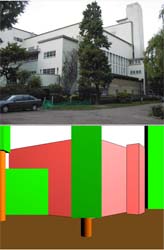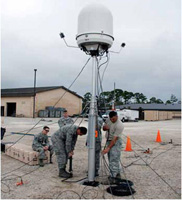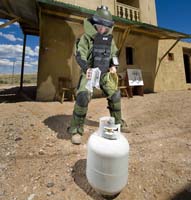Building Blocks for Computer Vision
It is difficult for computer vision systems such as those used on robotic platforms to make sense even of a single image; understanding more complex outdoor scenes remains one of the great challenges of artificial intelligence. But
a new vision system Carnegie Mellon University researchers developed enables computers to see the world through the eyes of a child. Similar to the way a child might assemble a building using blocks, the computer analyzes and approximates an outdoor scene using virtual building blocks to create a three-dimensional image based on volume and mass. The novel visual system allows the computer to replicate an image block by block, so that it can better understand the scene. It could eventually enable computers to understand spaces between buildings and other objects, or what might lie behind objects in the foreground, which would be helpful for robots planning a route. An image is first broken into segments corresponding to objects in the scene. Once the ground and sky are identified, other segments are assigned geometric shapes, which are categorized as light or heavy based on appearance, before being reconstructed using virtual building blocks. The National Science Foundation supported the research.
Mobile Weather Predictor
The
Electronic Systems Center’s Aerospace Management Systems Division Weather Systems Branch is working to provide U.S. Air Force decision makers improved weather sensing and viewing capabilities. In the hands of Air Force weather specialists around the globe, the
portable Doppler radar system will transmit data over the Global
Information Grid (GIG). Doppler radar helps weather predictors to see inside a storm and understand its structure. Connection to the GIG will enable weather operators to disseminate data much more rapidly, so that warfighters can make better decisions during operations. Four people can set up the system in less than 12 hours. It can provide information locally and also to military forecasters at regional forecast centers, who can tap into the data and provide it to decision makers. Initial operational capability is projected for December. The system, developed by LaPoint-Blase Industries,
St. Louis,
Missouri, is anticipated to go directly to
Southwest Asia to support ongoing operations.
Automated Messaging
The new version of the Automated Message Handling System (AMHS) will move to Microsoft Windows 2008 and Structured Query Language Server 2005 and includes an enhanced search engine. AMHS is widely used across the U.S. Defense Department with coalition partners and other government agencies. Messages sent using AMHS are encrypted or decrypted at the AMHS server so users don’t have to manage the complexities normally involved in message security protocols. AMHS 3.1.4 includes unified communication collaboration capabilities, such as instant messaging, Web and video conferencing, and application sharing. Previously, the Defense Department used a fixed infrastructure known as Automatic Digital Network (AUTODIN), where messages were sent to a communications center, printed and hand-delivered to a recipient’s mailbox. In the early 1990s, the U.S. Defense Information Systems Agency moved to a heavy client-server infrastructure called the Defense Message System, which was capable of handling attachments, such as maps, videos and spreadsheets. The newest software update to AMHS 3.1.4 will enhance ease of use and further improve the way organizational messages are securely delivered.
Water Blaster for Bombs
The Stingray Fluid Blade Disruptor, which is already headed to
U.S. troops in
Afghanistan in an effort to counter the threat of improvised explosive devices (IEDs), shoots a blade of water that can penetrate steel. IEDs are the number one threat to troops in
Afghanistan. The portable, clear plastic device is filled with water and uses an explosive material that, when detonated, creates a shock wave that travels through the water and accelerates it inward into a concave opening, producing a thin blade of water.
The high-speed, precise water blade slices through the IED. Immediately behind the water blade is a water slug that tears apart the bomb for good measure. The process happens in microseconds, too quickly to be seen by human eyes. Sandia National Laboratories licensed the patent-pending technology to TEAM Technologies Incorporated, which delivered the first 3,000 water disruptors to Afghanistan this summer. The device can be placed by an unmanned system and will likely be marketed to law enforcement and homeland security officials as well as the military.







Comments